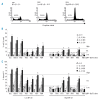Comparative analysis of oncogenic properties and nuclear factor-kappaB activity of latent membrane protein 1 natural variants from Hodgkin's lymphoma's Reed-Sternberg cells and normal B-lymphocytes
- PMID: 19211641
- PMCID: PMC2649341
- DOI: 10.3324/haematol.13269
Comparative analysis of oncogenic properties and nuclear factor-kappaB activity of latent membrane protein 1 natural variants from Hodgkin's lymphoma's Reed-Sternberg cells and normal B-lymphocytes
Abstract
Background: In Epstein-Barr virus-associated Hodgkin's lymphomas, neoplastic Reed-Sternberg cells and surrounding non-tumor B-cells contain different variants of the LMP1-BNLF1 oncogene. In this study, we raised the question of functional properties of latent membrane protein 1 (LMP1) natural variants from both Reed-Sternberg and non-tumor B-cells.
Design and methods: Twelve LMP1 natural variants from Reed-Sternberg cells, non-tumor B-cells of Hodgkin's lymphomas and from B-cells of benign reactive lymph nodes were cloned, sequenced and stably transfected in murine recombinant interleukin-3-dependent Ba/F3 cells to search for relationships between LMP1 cellular origin and oncogenic properties as well as nuclear factor-kappaB activation, and apoptosis protection.
Results: LMP1 variants of Reed-Sternberg cell origin were often associated with increased mutation rate and with recurrent genetic events, such as del15bp associated with S to N replacement at codon 309, and four substitutions I85L, F106Y, I122L, and M129I. Oncogenic potential (growth factor-independence plus clonogenicity) was consistently associated with LMP1 variants from Reed-Sternberg cells, but inconstantly for LMP1-variants from non-tumor B-cells. Analysis of LMP1 variants from both normal B-cells and Reed-Sternberg cells indicates that protection against apoptosis through activation of nuclear factor-kappaB - whatever the cellular origin of LMP1 - was maintained intact, regardless of the mutational pattern.
Conclusions: Taken together, our results demonstrate that preserved nuclear factor-kappaB activity and protection against apoptosis would be the minimal prerequisites for all LMP1 natural variants from both normal and tumor cells in Hodgkin's lymphomas, and that oncogenic potential would constitute an additional feature for LMP1 natural variants in Reed-Sternberg cells.
Figures




References
Publication types
MeSH terms
Substances
LinkOut - more resources
Full Text Sources
Research Materials
Miscellaneous

